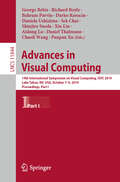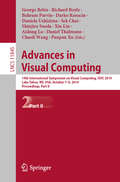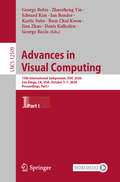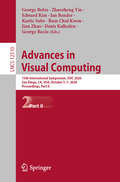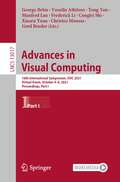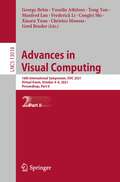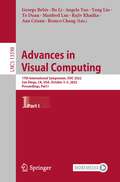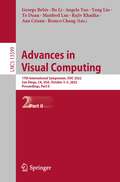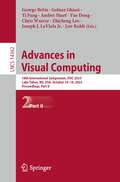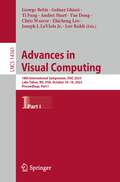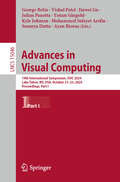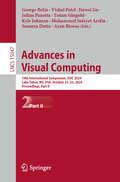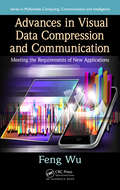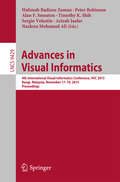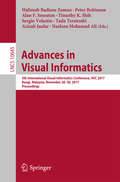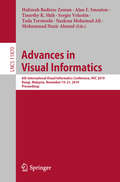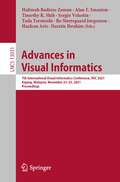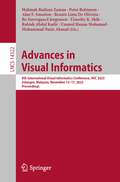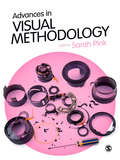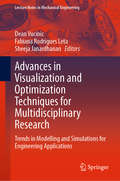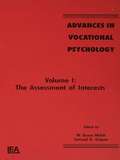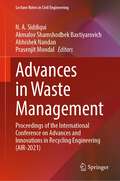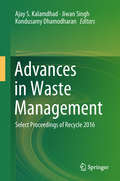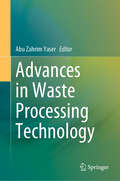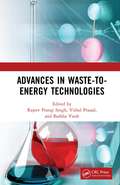- Table View
- List View
Advances in Visual Computing: 14th International Symposium on Visual Computing, ISVC 2019, Lake Tahoe, NV, USA, October 7–9, 2019, Proceedings, Part I (Lecture Notes in Computer Science #11844)
by Daniel Thalmann Xin Lin George Bebis Richard Boyle Bahram Parvin Darko Koracin Daniela Ushizima Sek Chai Shinjiro Sueda Aidong Lu Chaoli Wang Panpan XuThis book constitutes the refereed proceedings of the 14th International Symposium on Visual Computing, ISVC 2019, held in Lake Tahoe, NV, USA in October 2019. The 100 papers presented in this double volume were carefully reviewed and selected from 163 submissions. The papers are organized into the following topical sections: Deep Learning I; Computer Graphics I; Segmentation/Recognition; Video Analysis and Event Recognition; Visualization; ST: Computational Vision, AI and Mathematical methods for Biomedical and Biological Image Analysis; Biometrics; Virtual Reality I; Applications I; ST: Vision for Remote Sensing and Infrastructure Inspection; Computer Graphics II; Applications II; Deep Learning II; Virtual Reality II; Object Recognition/Detection/Categorization; and Poster.
Advances in Visual Computing: 14th International Symposium on Visual Computing, ISVC 2019, Lake Tahoe, NV, USA, October 7–9, 2019, Proceedings, Part II (Lecture Notes in Computer Science #11845)
by Daniel Thalmann Xin Lin George Bebis Richard Boyle Bahram Parvin Darko Koracin Daniela Ushizima Sek Chai Shinjiro Sueda Aidong Lu Chaoli Wang Panpan XuThis book constitutes the refereed proceedings of the 14th International Symposium on Visual Computing, ISVC 2019, held in Lake Tahoe, NV, USA in October 2019. The 100 papers presented in this double volume were carefully reviewed and selected from 163 submissions. The papers are organized into the following topical sections: Deep Learning I; Computer Graphics I; Segmentation/Recognition; Video Analysis and Event Recognition; Visualization; ST: Computational Vision, AI and Mathematical methods for Biomedical and Biological Image Analysis; Biometrics; Virtual Reality I; Applications I; ST: Vision for Remote Sensing and Infrastructure Inspection; Computer Graphics II; Applications II; Deep Learning II; Virtual Reality II; Object Recognition/Detection/Categorization; and Poster.
Advances in Visual Computing: 15th International Symposium, ISVC 2020, San Diego, CA, USA, October 5–7, 2020, Proceedings, Part I (Lecture Notes in Computer Science #12509)
by George Baciu George Bebis Edward Kim Jian Zhao Zhaozheng Yin Jan Bender Kartic Subr Bum Chul Kwon Denis KalkofenThis two-volume set of LNCS 12509 and 12510 constitutes the refereed proceedings of the 15th International Symposium on Visual Computing, ISVC 2020, which was supposed to be held in San Diego, CA, USA in October 2020, took place virtually instead due to the COVID-19 pandemic. The 114 full and 4 short papers presented in these volumes were carefully reviewed and selected from 175 submissions. The papers are organized into the following topical sections: Part I: deep learning; segmentation; visualization; video analysis and event recognition; ST: computational bioimaging; applications; biometrics; motion and tracking; computer graphics; virtual reality; and ST: computer vision advances in geo-spatial applications and remote sensing Part II: object recognition/detection/categorization; 3D reconstruction; medical image analysis; vision for robotics; statistical pattern recognition; posters
Advances in Visual Computing: 15th International Symposium, ISVC 2020, San Diego, CA, USA, October 5–7, 2020, Proceedings, Part II (Lecture Notes in Computer Science #12510)
by George Baciu George Bebis Edward Kim Jian Zhao Zhaozheng Yin Jan Bender Kartic Subr Bum Chul Kwon Denis KalkofenThis two-volume set of LNCS 12509 and 12510 constitutes the refereed proceedings of the 15th International Symposium on Visual Computing, ISVC 2020, which was supposed to be held in San Diego, CA, USA in October 2020, took place virtually instead due to the COVID-19 pandemic. The 118 papers presented in these volumes were carefully reviewed and selected from 175 submissions. The papers are organized into the following topical sections: Part I: deep learning; segmentation; visualization; video analysis and event recognition; ST: computational bioimaging; applications; biometrics; motion and tracking; computer graphics; virtual reality; and ST: computer vision advances in geo-spatial applications and remote sensing Part II: object recognition/detection/categorization; 3D reconstruction; medical image analysis; vision for robotics; statistical pattern recognition; posters
Advances in Visual Computing: 16th International Symposium, ISVC 2021, Virtual Event, October 4-6, 2021, Proceedings, Part I (Lecture Notes in Computer Science #13017)
by Xiaoru Yuan George Bebis Vassilis Athitsos Tong Yan Manfred Lau Frederick Li Conglei Shi Christos Mousas Gerd BruderThis two-volume set of LNCS 13017 and 13018 constitutes the refereed proceedings of the 16th International Symposium on Visual Computing, ISVC 2021, which was held in October 2021. The symposium took place virtually instead due to the COVID-19 pandemic. The 48 papers presented in these volumes were carefully reviewed and selected from 135 submissions. The papers are organized into the following topical sections: Part I: deep learning; computer graphics; segmentation; visualization; applications; 3D vision; virtual reality; motion and tracking; object detection and recognition. Part II: ST: medical image analysis; pattern recognition; video analysis and event recognition; posters.
Advances in Visual Computing: 16th International Symposium, ISVC 2021, Virtual Event, October 4-6, 2021, Proceedings, Part II (Lecture Notes in Computer Science #13018)
by Xiaoru Yuan George Bebis Vassilis Athitsos Tong Yan Manfred Lau Frederick Li Conglei Shi Christos Mousas Gerd BruderThis two-volume set of LNCS 13017 and 13018 constitutes the refereed proceedings of the 16th International Symposium on Visual Computing, ISVC 2021, which was held in October 2021. The symposium took place virtually instead due to the COVID-19 pandemic. The 48 papers presented in these volumes were carefully reviewed and selected from 135 submissions. The papers are organized into the following topical sections: Part I: deep learning; computer graphics; segmentation; visualization; applications; 3D vision; virtual reality; motion and tracking; object detection and recognition. Part II: ST: medical image analysis; pattern recognition; video analysis and event recognition; posters.
Advances in Visual Computing: 17th International Symposium, ISVC 2022, San Diego, CA, USA, October 3–5, 2022, Proceedings, Part I (Lecture Notes in Computer Science #13598)
by Yang Liu George Bebis Bo Li Manfred Lau Angela Yao Ye Duan Rajiv Khadka Ana Crisan Remco ChangThis two-volume set of LNCS 13598 and 13599 constitutes the refereed proceedings of the 17th International Symposium on Visual Computing, ISVC 2022, which was held in October 2022. The 61 papers presented in these volumes were carefully reviewed and selected from 110 submissions. They are organized in the following topical sections: Part I: deep learning I; visualization; object detection and recognition; deep learning II; video analysis and event recognition; computer graphics; ST: biomedical imaging techniques for cancer detection, diagnosis and management.Part II: ST: neuro-inspired artificia intelligence; applications; segmentation and tracking; virtual reality; poster.
Advances in Visual Computing: 17th International Symposium, ISVC 2022, San Diego, CA, USA, October 3–5, 2022, Proceedings, Part II (Lecture Notes in Computer Science #13599)
by Yang Liu George Bebis Bo Li Manfred Lau Angela Yao Ye Duan Rajiv Khadka Ana Crisan Remco ChangThis two-volume set of LNCS 13598 and 13599 constitutes the refereed proceedings of the 17th International Symposium on Visual Computing, ISVC 2022, which was held in October 2022. The 61 papers presented in these volumes were carefully reviewed and selected from 110 submissions. They are organized in the following topical sections: Part I: deep learning I; visualization; object detection and recognition; deep learning II; video analysis and event recognition; computer graphics; ST: biomedical imaging techniques for cancer detection, diagnosis and management.Part II: ST: neuro-inspired artificia intelligence; applications; segmentation and tracking; virtual reality; poster.
Advances in Visual Computing: 18th International Symposium, ISVC 2023, Lake Tahoe, NV, USA, October 16–18, 2023, Proceedings, Part II (Lecture Notes in Computer Science #14362)
by Yue Dong George Bebis Luv Kohli Joseph J. LaViola Jr. Yi Fang Golnaz Ghiasi Andrei Sharf Chris Weaver Zhicheng LeoThis volume LNCS 14361 and 14362 constitutes the refereed proceedings of the, 16th International Symposium, ISVC 2023, in October 2023, held at Lake Tahoe, NV, USA.The 42 full papers and 13 poster papers were carefully reviewed and selected from 120 submissions. A total of 25 papers were also accepted for oral presentation in special tracks from 34 submissions. The following topical sections followed as:Part 1: ST: Biomedical Image Analysis Techniques for Cancer Detection, Diagnosis and Management; Visualization; Video Analysis and Event Recognition; ST: Innovations in Computer Vision & Machine Learning for Critical & Civil Infrastructures; ST: Generalization in Visual Machine Learning; Computer Graphics; Medical Image Analysis; Biometrics; Autonomous Anomaly Detection in Images; ST: Artificial Intelligence in Aerial and Orbital Imagery; ST: Data Gathering, Curation, and Generation for Computer Vision and Robotics in Precision Agriculture.Part 2: Virtual Reality; Segmentation; Applications; Object Detection and Recognition; Deep Learning; Poster.
Advances in Visual Computing: 18th International Symposium, ISVC 2023, Lake Tahoe, NV, USA, October 16–18, 2023, Proceedings, Part I (Lecture Notes in Computer Science #14361)
by Yue Dong George Bebis Luv Kohli Joseph J. LaViola Jr. Yi Fang Golnaz Ghiasi Andrei Sharf Chris Weaver Zhicheng LeoThis volume LNCS 14361 and 14362 constitutes the refereed proceedings of the, 16th International Symposium, ISVC 2023, in October 2023, held at Lake Tahoe, NV, USA.The 42 full papers and 13 poster papers were carefully reviewed and selected from 120 submissions. A total of 25 papers were also accepted for oral presentation in special tracks from 34 submissions. The following topical sections followed as:Part 1: ST: Biomedical Image Analysis Techniques for Cancer Detection, Diagnosis and Management; Visualization; Video Analysis and Event Recognition; ST: Innovations in Computer Vision & Machine Learning for Critical & Civil Infrastructures; ST: Generalization in Visual Machine Learning; Computer Graphics; Medical Image Analysis; Biometrics; Autonomous Anomaly Detection in Images; ST: Artificial Intelligence in Aerial and Orbital Imagery; ST: Data Gathering, Curation, and Generation for Computer Vision and Robotics in Precision Agriculture.Part 2: Virtual Reality; Segmentation; Applications; Object Detection and Recognition; Deep Learning; Poster.
Advances in Visual Computing: 19th International Symposium, ISVC 2024, Lake Tahoe, NV, USA, October 21–23, 2024, Proceedings, Part I (Lecture Notes in Computer Science #15046)
by George Bebis Vishal Patel Kyle Johnsen Jinwei Gu Julian Panetta Yotam Gingold Mohammed Safayet Arefin Soumya Dutta Ayan BiswasThis two-volume set LNCS 15046 and 15047 constitutes the refereed proceedings of the 17th International Symposium, ISVC 2024, held at Lake Tahoe, NV, USA, during October 21-23, 2024. The 54 full papers and 12 poster papers were carefully reviewed and selected from 120 submissions. A total of 8 papers were also accepted for oral presentation in special tracks from 15 submissions. The papers cover the following topical sections: Part I: Deep Learning; Computer Graphics; Video Analysis and Event Recognition; Motion and Tracking; Detection and Recognition; Visualization, and Medical Image Analysis. Part II: Segmentation; Recognition; Generalization in Visual Machine Learning; Vision and Robotics for Agriculture; Virtual Reality; Applications, and Poster.
Advances in Visual Computing: 19th International Symposium, ISVC 2024, Lake Tahoe, NV, USA, October 21–23, 2024, Proceedings, Part II (Lecture Notes in Computer Science #15047)
by George Bebis Vishal Patel Kyle Johnsen Jinwei Gu Julian Panetta Yotam Gingold Mohammed Safayet Arefin Soumya Dutta Ayan BiswasThis two-volume set LNCS 15046 and 15047 constitutes the refereed proceedings of the 17th International Symposium, ISVC 2024, held at Lake Tahoe, NV, USA, during October 21-23, 2024. The 54 (60) full papers and 12 poster papers were carefully reviewed and selected from 120 submissions. A total of 8 (13) papers were also accepted for oral presentation in special tracks from 15 submissions. The papers cover the following topical sections: Part I: Deep Learning; Computer Graphics; Video Analysis and Event Recognition; Motion and Tracking; Detection and Recognition; Visualization, and Medical Image Analysis. Part II: Segmentation; Recognition; Generalization in Visual Machine Learning; Vision and Robotics for Agriculture; Virtual Reality; Applications, and Poster.
Advances in Visual Data Compression and Communication: Meeting the Requirements of New Applications (Multimedia Computing, Communication and Intelligence #5)
by Feng WuThis book provides a theoretical and technical basis for advanced research on visual data compression and communication. It presents the results of the author's research on visual data compression and transmission. Studying scalable video coding (SVC), it considers the fundamental problem to be solved in SVC-motion compensation. It explores directional transforms, extends the current coding framework by visual synthesis and reconstruction, and explains how to apply compressive sensing to solve the compression problems in transmission. It also develops the pseudo-analog transmission for image and video.
Advances in Visual Informatics: 4th International Visual Informatics Conference, IVIC 2015, Bangi, Malaysia, November 17-19, 2015, Proceedings (Lecture Notes in Computer Science #9429)
by Peter Robinson Timothy K. Shih Halimah Badioze Zaman Alan F. Smeaton Sergio Velastin Azizah Jaafar Nazlena Mohamad AliThis book constitutes the refereed proceedings of the Fourth International Conference on Advances in Visual Informatics, IVIC 2015, held in Bangi, Malaysia, in November 2015. The five keynotes and 45 papers presented were carefully reviewed and selected from 82 initial submissions. The papers are organized in four tracks on visualization and big data; machine learning and computer vision; computer graphics; as well as virtual reality.
Advances in Visual Informatics: 5th International Visual Informatics Conference, IVIC 2017, Bangi, Malaysia, November 28–30, 2017, Proceedings (Lecture Notes in Computer Science #10645)
by Peter Robinson Timothy K. Shih Halimah Badioze Zaman Alan F. Smeaton Sergio Velastin Azizah Jaafar Nazlena Mohamad Ali Tada TerutoshiThis book constitutes the refereed proceedings of the 5th International Conference on Advances in Visual Informatics, IVIC 2017, held in Bangi, Malaysia, in November 2017. The keynote and 72 papers presented were carefully reviewed and selected from 130 submissions. The papers are organized in the following topics: Visualization and Data Driven Technology; Engineering and Data Driven Innovation; Data Driven Societal Well-being and Applications; and Data Driven Cyber Security.
Advances in Visual Informatics: 6th International Visual Informatics Conference, IVIC 2019, Bangi, Malaysia, November 19–21, 2019, Proceedings (Lecture Notes in Computer Science #11870)
by Timothy K. Shih Halimah Badioze Zaman Alan F. Smeaton Sergio Velastin Nazlena Mohamad Ali Tada Terutoshi Mohammad Nazir AhmadThis book constitutes the refereed proceedings of the 6th International Conference on Advances in Visual Informatics, IVIC 2019, held in Bangi, Malaysia, in November 2019.The 65 papers presented were carefully reviewed and selected from 130 submissions. The papers are organized into the following topics: Visualization and Digital Innovation for Society 5.0; Engineering and Digital Innovation for Society 5.0; Cyber Security and Digital Innovation for Society 5.0; and Social Informatics and Application for Society 5.0.
Advances in Visual Informatics: 7th International Visual Informatics Conference, IVIC 2021, Kajang, Malaysia, November 23–25, 2021, Proceedings (Lecture Notes in Computer Science #13051)
by Timothy K. Shih Halimah Badioze Zaman Alan F. Smeaton Sergio Velastin Tada Terutoshi Bo Nørregaard Jørgensen Hazleen Aris Nazrita IbrahimThis book constitutes the refereed proceedings of the 7th International Conference on Advances in Visual Informatics, IVIC 2021, held in Selangor, Malaysia in November 2021. The 59 papers presented were carefully reviewed and selected from 114 submissions. The papers are organized into the following topics: Visualization and Digital Innovation; Engineering and Digital Innovation; Cyber Security and Digital Innovation; and Energy Informatics and Digital Innovation.
Advances in Visual Informatics: 8th International Visual Informatics Conference, IVIC 2023, Selangor, Malaysia, November 15–17, 2023, Proceedings (Lecture Notes in Computer Science #14322)
by Peter Robinson Timothy K. Shih Halimah Badioze Zaman Alan F. Smeaton Mohammad Nazir Ahmad Bo Nørregaard Jørgensen Renato Lima De Oliveira Rabiah Abdul Kadir Ummul Hanan MohamadThis book constitutes the refereed proceedings of the 8th International Conference on Advances in Visual Informatics, IVIC 2023, held in Selangor, Malaysia in November 2023.The 51 full papers presented were carefully reviewed and selected from 101 submissions. The conference focused on 6 tracks: Modeling and Simulation, Mixed Reality and HCI, Systems Integration and IoT, Cybersecurity, Energy Informatics and Intelligent Data Analytics.
Advances in Visual Methodology
by Sarah PinkA stunning collection of cutting-edge essays which brings together the leading scholars in visual research. Clearly structured, and written in an engaging and accessible style throughout, this invigorating work will be the 'must have' text for teachers and students of `the visual' across the arts, humanities and social sciences. - Elaine Campbell, Reader in Criminology, Newcastle University This is a book about research that takes the challenge of the internet seriously, that rises above disciplinary difference and points to new directions for social research. - Rob Walker, Emeritus Professor, University of East Anglia This innovative book examines and introduces cutting edge visual methods in social research. It explores the development of visual methodology as a field of interdisciplinary and post-disciplinary practice spanning scholarly and applied concerns. Positioned at the innovative edge of theory and practice in contemporary visual research, Pink's engaging book goes beyond the methods, ideas and fields of practice outlined in existing texts and handbooks. This book examines: -How new theoretical and methodological engagements are developing and emerging in research practice; -the impact new approaches are having on the types of knowledge visual research produces and critiques; -the ways visual research intersects with new media; -and the implications for social and cultural research, scholarship and intervention. This book will be essential reading for any student or researcher thinking of using visual methods in their own research. Sarah Pink is Professor of Social Sciences at Loughborough University.
Advances in Visualization and Optimization Techniques for Multidisciplinary Research: Trends in Modelling and Simulations for Engineering Applications (Lecture Notes in Mechanical Engineering)
by Fabiana Rodrigues Leta Dean Vucinic Sheeja JanardhananThis volume presents several multidisciplinary approaches to the visual representation of data acquired from experiments. As an expansion of these approaches, it is also possible to include data examination generated by mathematical-physical modeling. Imaging Systems encompass any subject related to digital images, from fundamental requirements for a correct image acquisition to computational algorithms that make it possible to obtain relevant information for image analysis. In this context, the book presents selected contributions of a special session at the Conference on Advanced Computational Engineering and Experimenting (ACE-X) 2016.
Advances in Vocational Psychology: Volume 1: the Assessment of interests (Contemporary Topics in Vocational Psychology Series)
by W. Bruce Walsh, Samuel H. OsipowAdvances in Vocational Psychology devoted to presenting and evaluating important advances in the field of interest measurement. Progress in three well known interest inventories -- the Strong Campbell Interest Inventory, the Kuder Occupational Interest Survey, and the Self Directed Search -- is closely examined. A focus on innovations in interest measurement directs attention to how more recent instruments provide technical and conceptual advances over older, more reliable ones. Both research and counseling perspectives combine to provide a well-balanced guide to the study of vocational psychology. How interest inventories can be used beneficially in the career counseling of minority and majority populations is also explored.
Advances in Waste Management: Proceedings of the International Conference on Advances and Innovations in Recycling Engineering (AIR-2021) (Lecture Notes in Civil Engineering #301)
by N. A. Siddiqui Prasenjit Mondal Akmalov Shamshodbek Baxtiyarovich Abhishek NandanThis book comprises papers from the International Conference on Advances and Innovations in Recycling Engineering (AIR-2021). It highlights indispensable issues, challenges, and recommended solutions related to solid waste management and sustainability. The contents deal with recommended solutions and the gap between environmental laws related to recycling of waste and environment threat. Weighing the global economy loss via compromises on industrial growth versus environment provides another dimension to the study and press on the need for alternative practices. The impact on biodiversity conservation and natural resources pollutants is also highlighted. This book will be a useful guide for academics, researchers, and policymakers working in the fields of waste management.
Advances in Waste Management: Select Proceedings of Recycle 2016
by Ajay S. Kalamdhad Jiwan Singh Kondusamy DhamodharanThis book presents some of the latest technologies in waste management, and emphasizes the benefits that can be gained from the use of recycled products. Divided into four sections, it deals with phytoremediation, acquatic weed management and the treatment of solid- and water-based wastes, such as those arising from agricultural, industrial and medical activities. With its special emphasis on the utilization of recycled products, this volume will be of interest to students, academicians, policy makers and others who have a practical and academic interest in dealing with the waste society generates.
Advances in Waste Processing Technology
by Abu Zahrim YaserThis book highlights the latest research on waste processing technologies, particularly for domestic, agricultural, and petroleum based pollutants, intended to achieve waste valorisation. In addition, it discusses the important role of plastic recycling, as well as advanced waste processing techniques.
Advances in Waste-to-Energy Technologies
by Rajeev Pratap Singh Vishal Prasad Barkha VaishAs global populations continue to increase, the application of biotechnological processes for disposal and control of waste has gained importance in recent years. Advances in Waste-to-Energy Technologies presents the latest developments in the areas of solid waste management, Waste-to-Energy (WTE) technologies, biotechnological approaches, and their global challenges. It combines biotechnological procedures, sophisticated modeling, and techno-economic analysis of waste, and examines the current need for the maximum recovery of energy from wastes as well as the associated biotechnological and environmental impacts. Features: Presents numerous waste management practices and methods to recover resources from waste using the best biotechnological approaches available. Addresses the challenges, management, and policy issues of waste management and WTE initiatives. Includes practical case studies from around the world. Serves as a useful resource for professionals and students involved in cross-disciplinary and trans-disciplinary research programs and related courses. Discusses the economic and regulatory contexts for managing waste. This book will serve as a valuable reference for researchers, academicians, municipal authorities, government bodies, waste managers, building engineers, and environmental consultants requiring an understanding of waste management and the latest WTE technologies.
